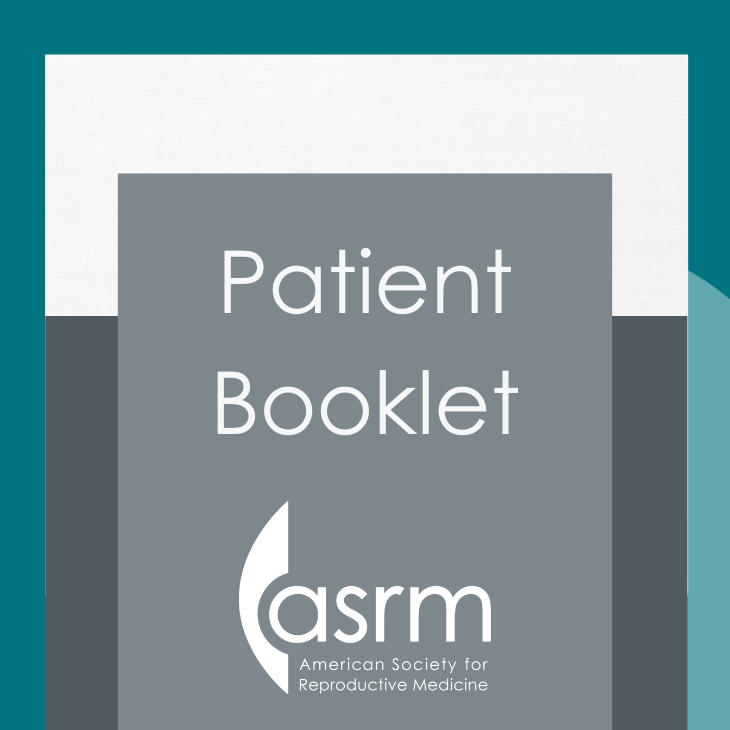
Revised 2017
INTRODUCTION
Infertility is typically defined as the inability to achieve pregnancy after one year of unprotected intercourse. If you have been trying to conceive for a year or more, you should consider an infertility evaluation. However, if you are 35 years or older, you should consider beginning the infertility evaluation after about six months of unprotected intercourse rather than a year, so as not to delay potentially needed treatment. If you have a reason to suspect an underlying problem, you should seek care earlier.For instance, if you have very irregular menstrual cycles (suggesting that you are not ovulating or releasing an egg), or if you or your partner has a known fertility problem, you probably should not wait an entire year before seeking treatment. If you and your partner have been unable to have a baby, you’re not alone. At least one out of seven couples has trouble conceiving. When attempting pregnancy and unsuccessful, it is normal to experience feelings of frustration, jealousy, anger, and stress. However, once you begin to explore your medical options, you’ll find that fertility treatments offer more hope for a successful pregnancy than ever before. The majority of patients who seek care from a fertility specialist reach their goal of becoming pregnant.
THE INITIAL VISIT
Your regular gynecologist may perform the initial fertility evaluation, or you may choose to be evaluated by an infertility specialist. It is important to find a physician you trust and with whom you feel comfortable. Some general obstetricians/gynecologists (OB/GYNs) have a special interest in the treatment of infertility. Reproductive endocrinologists are specialized OB/GYNs who, after completing the full OB/GYN residency, complete three additional years of specialized training in reproductive endocrinology and infertility at an approved fellowship program. If an abnormal semen analysis is known, or later found, the male partner should be referred to a urologist who specializes in the area of male infertility. To locate physicians in your area who specialize in female or male infertility issues, go to the ASRM patient website https://www.ReproductiveFacts.org and click on “Find a Healthcare Professional”. You can search for a health professional by name, city, and specialty.
Once you choose a qualified physician, you and your partner will undergo a series of tests. Sometimes this may require a significant amount of time and energy on your part, but the results are invaluable. Before these tests are performed, your physician will ask questions and review any records that you and your partner may have from a previous infertility evaluation. Ensuring that your physician has access to review previous medical records is critical in minimizing wasted time and money for repeated diagnostic evaluation and therapy. Both you and your partner should try to attend the first meeting with your physician since infertility is a shared experience and is best dealt with as a couple. During this visit, you’ll begin to understand the degree of commitment and cooperation that an infertility investigation requires. It is important that you communicate honestly with your partner as well as with your physician.
Your physician will review your history and ask you and your partner questions to help identify potential causes for your difficulty in conceiving. In a typical initial visit, the physician will ask about the frequency and regularity of your menstrual period, pelvic pain, abnormal vaginal bleeding or discharge, history of pelvic infection, and medical illnesses. Expect questions concerning prior pregnancies, miscarriages, operations, and methods of contraception. Your partner will be asked questions concerning prior genital injury, surgery, infections, drug and/or medication use, history of fathering other children, and medical illnesses. You’ll be asked how long you’ve been trying to conceive, how often you have sexual intercourse, if you use lubricants during intercourse, and if anyone in either family has birth defects. You may be asked if you or your partner experience(s) any pain or difficulty with sexual intercourse (such as difficulty with developing/maintaining an erection or with ejaculation) as these issues may interfere with your natural ability to conceive. Your physician will need to know your and your partner’s complete sexual and reproductive histories, including any former relationships. Since at least 25% of infertile couples have more than one factor causing infertility, it is very important to evaluate all factors that may affect both you and your partner.
During the first visit, you may discuss the emotional stress of infertility, a subject that is often difficult for you to share with family and friends.
Physicians know that the procedures and intimate questions involved in an infertility workup can be difficult. You should always feel free to make your physician aware of your concerns and frustrations and you should ask your physician questions whenever you need clarification. A physical examination of you and your partner may follow the initial review. The occurrence and extent of the examinations will depend upon whether or not any factors impacting your fertility are found early in the evaluation.
This is also an opportunity to discuss plans to maximize your chances to have a healthy pregnancy. This includes eating healthy, avoiding alcohol and recreational drugs, as well as starting prenatal vitamins. You should speak with your health-care provider about which medications may be unsafe in pregnancy and may require adjustments. You should be screened to assess your risk of exposure to viruses that may affect your pregnancy and make sure your vaccinations are up to date. In addition, you may be screened for genetic illnesses you might carry that do not affect you, but may be passed on to a child.
THE PROCESS OF BECOMING PREGNANT
Figure 1

FERTILITY FACTORS
The Ovulation Factor
Problems with ovulation are common causes of infertility, accounting for approximately 25% of all infertility cases. Ovulation involves the release of a mature egg from one of your ovaries. After ovulation, the ovary produces the hormone progesterone. During the 12 to 16 days before menstruation begins, progesterone prepares the lining of your uterus into an optimal environment for implantation and nurturing of the fertilized egg. If you have regular menstrual cycles, you are probably ovulating. Cycle lengths of approximately 24 to 34 days (from the beginning of one period to the beginning of the next period) are usually ovulatory. If you only have a period every few months or not at all, you are probably not ovulating or are ovulating infrequently.
Though it is cumbersome and not routinely recommended, charting your basal body temperature (BBT) is a simple, inexpensive way to see if you are ovulating. To complete a BBT chart (Figure 2), you must take your temperature by mouth each morning the moment you wake (before you get up) for at least one month and record the temperature under the appropriate date. Normally, the release of progesterone due to ovulation causes a mid-cycle temperature rise of 0.5 to 1.0 degrees Fahrenheit, indicating that ovulation has occurred. However, some women who ovulate normally may not have a rise in temperature, and many factors unrelated to the reproductive cycle, such as a cold or fatigue, can affect the BBT. At best, the BBT chart helps determine when and if ovulation is taking place, but only after it has happened.
Figure 2

To predict ovulation before it takes place, in order to schedule intercourse or insemination, for example, you may use an over-the-counter ovulation prediction kit. These urine test kits are designed to detect the surge of luteinizing hormone (LH) that occurs just before you ovulate. The LH surge stimulates one of the ovaries to release an egg and produce progesterone. Ovulation prediction kits usually detect the LH surge about a day or a day and a half before ovulation, giving you and your partner advance notice of an egg that will be released (ovulation). However, not all women who ovulate will have an LH surge that will be detected using these kits. You may find these kits difficult and frustrating, and false-positive and false-negative results do occur occasionally.
In a normal cycle, progesterone levels are highest about seven days after ovulation. Your physician may perform a blood test to measure the level of progesterone in your blood at this time. Generally, blood progesterone is tested on day 19 to 23 of a 28-day menstrual cycle. An elevated progesterone level helps to confirm ovulation and the adequacy of ovarian hormone production.
Your physician may perform a pelvic ultrasound examination to evaluate ovulation, but this is not done routinely. This examination may indicate whether your ovaries are producing follicles. These follicles are fluid-filled sacs located just beneath the ovary’s surface that contain the immature eggs. Ultrasound may also help to document a follicle’s collapse and subsequent release of fluid, implying release of a mature egg.
If you are not ovulating, your physician may order special tests to determine the reason and then prescribe certain drugs to induce ovulation (see ASRM patient education factsheet “Oral medications for inducing ovulation”). Your medical history and physical exam will help determine which tests are appropriate. Both oral and injectable medications are available to help induce your ovulation.
The Age Factor
Delaying pregnancy is a common choice for women in today’s society. The number of women in their late 30s and 40s attempting pregnancy and having babies has increased in recent years. You may not realize that your fertility begins to decline significantly in your mid 30s and the decline gets faster in your late 30s. Some women even begin to experience a decline in their fertility in their late 20s and early 30s. Fertility declines with age because fewer eggs remain in your ovaries, and the quality of the eggs remaining is lower than when you were younger. Blood tests are now available to estimate your ovarian reserve, a term which reflects your age-related fertility potential. In the simplest of these tests, follicle-stimulating hormone (FSH), and estradiol are tested in your blood on the second, third, or fourth day of your menstrual period. An elevated FSH level indicates that your chances for pregnancy may be lower than routinely expected for your age, especially if you are age 35 or older. Testing of antimüllerian hormone (AMH) level is also another way to evaluate and possibly provide additional information about your ovarian reserve. A lower AMH level indicates decreased ovarian reserve. Abnormally high FSH or low AMH levels do not mean that you have no chance of successful conception. However, they may indicate that more aggressive treatment may be warranted. Another commonly used option to detect ovarian reserve is the use of transvaginal ultrasound to determine antral follicle count (AFC), which is when each follicle in both ovaries are counted. An AFC is performed during the first 3-4 days of the menstrual cycle. Studies show that decreased ovarian reserve is associated with fewer eggs available, but does not change the ability to get pregnant. However, it may be more difficult to conceive.
The Tubal Factor
Because open and functional fallopian tubes are necessary to get pregnant without assistance, tests to determine tubal openness (patency) are important. Tubal factors, as well as factors affecting the peritoneum (lining of the pelvis and abdomen), account for about 35% of all infertility problems. A special x-ray called a hysterosalpingogram (HSG) (Figure 3) can be done to evaluate the fallopian tubes and uterus (see ASRM patient factsheet, “Hysterosalpingogram”). During an HSG, a special fluid (dye) is injected through your cervix, fills your uterus, and travels into your fallopian tubes. If the fluid spills out the ends of the tubes, they are open. If the fluid does not spill out the ends, then the tubes are likely blocked. It is important to note that tubes might still be open even if no spill is seen. If the HSG shows blocked fallopian tubes, your physician may perform a laparoscopy to assess the degree of tubal damage. An HSG is typically done after your period stops and before ovulation.
Figure 3

If the tubes are found to be blocked, scarred, or damaged, surgery can sometimes correct the problem. But surgery does not guarantee that the tube, even if opened up or cleared of scar tissue, will function properly. Although some tubal problems are correctable by surgery, women with severely damaged tubes are so unlikely to become pregnant that in vitro fertilization (IVF) offers them the best hope for a successful pregnancy. Because very badly damaged tubes may fill with fluid (hydrosalpinx) and lower IVF success rates, your physician may recommend removal of the damaged tubes prior to IVF. More information on tubal disease can be found in the ASRM patient education factsheet on, Tubal Factor Infertility.
The Male Factor
In approximately 40% of infertile couples, the male partner is either the sole or a contributing cause of infertility. Therefore, a semen analysis is important in the initial evaluation. To prepare for a semen analysis, your partner will be asked to abstain from ejaculating for 2-5 days. He then will collect a semen sample in a cup by masturbating at home or in the physician’s office. In some instances, a semen sample may be obtained during sexual intercourse using a special condom provided by the physician. The semen specimen is examined under a microscope to determine the volume (amount), count, motility (movement), and morphology (appearance and shape) of the sperm. In general, two or three semen analyses may be recommended over two to six months, since sperm quality can vary over time. Other hormonal and genetic tests may be recommended as well, depending on the type and severity of abnormalities found.
If your partner’s semen analysis reveals abnormalities, he may need to consult a doctor who specializes in male infertility. Treatment for male factor infertility may include surgical correction of varicocele (dilated or varicose veins in the scrotum) or duct obstruction or medications to improve sperm production. In some men, surgery to obtain sperm from the testis can be performed. In some cases, no obvious cause of poor sperm quality can be found. Intrauterine insemination (IUI) or IVF may then be recommended. Direct injection of a single sperm into an egg (intracytoplasmic sperm injection [ICSI]) may be recommended as a part of the IVF process. For more information, refer to the ASRM patient education factsheets “Male Infertility” and “Vasectomy Reversal.” If no sperm are present on semen analysis or not found at surgical extraction, your physician may discuss using a sperm donor. Insemination with donor sperm also may be considered if IUI is not successful or if you and your partner do not choose to undergo IVF. For more detailed information about IUI, please see the ASRM patient factsheet, “Intrauterine insemination (IUI).” For more detailed information about IVF, please see the ASRM patient booklet, Assisted reproductive technology (ART).
Older women tend to have a lower response to fertility medications and a higher miscarriage rate than younger women. The chance of having a chromosomally abnormal embryo, such as one with Down syndrome, also increases with age. Because of the marked effect of age on pregnancy and birth rates, it is common for older couples to begin fertility treatment sooner, and, in some cases, to consider more aggressive treatment than younger couples.
Possible treatments for age-related infertility in women include fertility drugs plus IUI or IVF. In cases where the treatments fail or are predicted to have a low chance of success, egg donation is an option. Egg donation has a high chance of success, regardless of your FSH level. More recently, embryo donation has also become a viable option for many couples. For couples who have not succeeded with fertility treatments or who choose to forgo treatment, adoption is another option. For more information about these topics, please consult the ASRM patient booklets, Age and Fertility, Assisted Reproductive Technology, and Third-party Reproduction.
The Cervical/Uterine Factor
Conditions within the cervix, which is the lower part of the uterus, may impact your fertility, but they are rarely the sole cause of infertility. It is important for your physician to know if you have had prior biopsies such as a cone biopsy, surgery, “freezing” and/or laser treatment of the cervix (LEEP), abnormal pap smears, or if your mother took DES (diethylstilbestrol) while she was pregnant. These issues can sometimes increase a woman’s risk for having infertility and/or pregnancy complications such as miscarriage, preterm labor, and premature births. Fertility problems associated with the cervix are generally treated with antibiotics, hormones, or by IUI.
The HSG test, often used to investigate the fallopian tubes, can also reveal defects inside the uterine cavity, which is the hollow space inside your uterus where an embryo would implant and develop. Possible uterine abnormalities that may be identified include scar tissue, polyps (bunched-up pieces of the endometrial lining), fibroids, or an abnormally shaped uterine cavity. Problems within your uterus may interfere with implantation of the embryo or may increase the incidence of miscarriage. Hysteroscopy, a minor and minimally invasive, incision-free surgical procedure, may be required to further evaluate and possibly correct uterine structural problems.
Uterine abnormalities also can be seen with a saline sonohysterogram (SHG). This test also may be called a sonohysterogram or water (hydro) ultrasound. An SHG is a pelvic ultrasound performed while sterile fluid is injected through your cervix to outline the uterine cavity. Unlike the HSG, the SHG shows the contour of the wall of the uterus, as well as the cavity at the same time, a difference which can help identify scar tissue, polyps, and fibroids. For more information about these topics, please consult the ASRM patient education factsheets “Fibroids and fertility,” “Intrauterine adhesions: what are they?,” “Hysterosalpingogram (HSG),” and “Saline infusion sonohysterogram (SHG)” and the ASRM patient education booklet, Abnormal Uterine Bleeding.
The Peritoneal Factor
Peritoneal factor infertility refers to abnormalities involving the peritoneum (lining of the surfaces of your internal organs) such as scar tissue (adhesions) or endometriosis (Figure 4). Endometriosis is a condition where tissue that normally lines the uterus begins to grow outside the uterus. This tissue may grow on any structure within the pelvis, including the ovaries, and is found in about 35% of infertile women who have no other diagnosable infertility problem. Endometriosis is found more commonly in women with infertility, pelvic pain, and painful intercourse. Endometriosis may affect the function of the ovaries, your ovarian reserve, the function of the fallopian tubes, and implantation. For further information concerning this problem, see the ASRM patient education booklet, Endometriosis.
Figure 4

Figure 5

During laparoscopy, a dye may be injected through the cervix to determine if the passage to the uterus and tubes is open. One or more additional smaller incisions may be made above your pubic area in order for the physician to insert additional instruments to better examine your pelvic organs and treat any disease, if found.
A variety of specialized surgical instruments, including robotic-controlled instruments and lasers, may now be used laparoscopically to treat such conditions as endometriosis, adhesions, and ovarian cysts such as endometriomas (fluid-filled cysts on the ovaries). In many cases, laparotomy, which involves a larger abdominal incision than laparoscopy and an approximately six-week recovery, is no longer necessary since many problems can now be treated laparoscopically.
Although it is reasonable and sometimes advisable to perform laparoscopy to identify and treat pelvic disease, this procedure is not routinely performed in every infertility evaluation or part as the initial infertility evaluation. Laparoscopy is expensive and involves some small surgical risk. You and your physician should discuss whether or not laparoscopy is recommended in your particular case. Sometimes your physician may not recommend a laparoscopy initially, but may instead recommend it at a later time depending on your response to treatment.
Unexplained Infertility
In approximately 10% of couples trying to get pregnant, all of the above tests are normal and there is no easily identifiable cause for infertility. In a much higher percentage of couples, only minor abnormalities are found that should not be severe enough to result in infertility. In these cases, the infertility is referred to as “unexplained.” Couples with unexplained infertility may have problems with egg quality, fertilization, genetics, tubal function, or sperm function that are difficult to diagnose and/or treat. Fertility drugs and IUI have been used in couples with unexplained infertility with limited success. If no pregnancy occurs within three to six treatment cycles, IVF may be recommended, and has been shown to be the most effective treatment for unexplained infertility.
GENETIC ABNORMALITIES
CHANCES OF SUCCESS WITH IVF
PSYCHOLOGICAL IMPLICATIONS
SUMMARY
GLOSSARY
Adhesions. Bands of fibrous scar tissue that may bind the pelvic organs and/or loops of bowel together. Adhesions can result from infections, endometriosis, or previous surgeries.
Antimüllerian hormone (AMH). A hormone measurement that reflects your ovaries’ capability for producing eggs.
Antral follicle count (AFC). A transvaginal ultrasound machine is used to determine the number of pre-stimulated follicles in the ovary during the first 3-4 days of the menstrual cycle.
Assisted reproductive technologies (ART). All treatments that include laboratory handling of eggs, sperm, and/or embryos. The most common examples of ART are in vitro fertilization (IVF), intracytoplasmic sperm injection (ICSI), preimplantation genetic testing (PGT), frozen embryo transfer (FET), donor egg, and donor embryo transfer.
Cervix. The narrow, lower part of the uterus that opens into the vagina. The cervical canal runs through the cervix and connects the vagina with the uterine cavity. The cervix produces mucus through which sperm must swim before entering the uterine cavity and then the fallopian tubes.
Egg donation. The process of fertilizing eggs from a donor with the male partner’s sperm in a laboratory dish and transferring the resulting embryos to the female partner’s uterus. The female partner will not be biologically related to the child, although she will be the birth mother on record. The male partner will be biologically related to the child.
Endometriosis. A condition where endometrial-like tissue (the tissue that lines the uterus) develops outside of the uterine cavity in abnormal locations such as the ovaries, fallopian tubes, and abdominal cavity. This tissue can grow with hormonal stimulation and cause pain, inflammation, and scar tissue. It may also be associated with infertility.
Estradiol. The predominant estrogen (hormone) produced by the follicles on the ovary.
Fallopian tubes. A pair of hollow tubes attached one on each side of the uterus through which the egg travels from the ovary to the uterus.
Fibroids. Benign (non-cancerous) tumors of the uterine muscle wall that can cause abnormal uterine bleeding, pelvic pain, and interfere with pregnancy.
Follicle. A fluid-filled sac located just beneath the surface of the ovary, containing an egg (oocyte) and cells that produce hormones. The sac increases in size and volume during the first half of the menstrual cycle and at ovulation, the follicle matures and ruptures, releasing the egg. As the follicle matures, it can be visualized by ultrasound.
Follicle stimulating hormone (FSH). In women, FSH is the pituitary hormone responsible for stimulating follicular cells in the ovary to grow, stimulating egg development and the production of the female hormone estrogen. In the male, FSH is the pituitary hormone which travels through the bloodstream to the testes and helps stimulate them to manufacture sperm. FSH can also be given as a medication.
Hysteroscopy. A procedure in which a lighted scope (hysteroscope) is inserted through the cervix into the uterus to enable the physician to view the inside of the uterus to diagnose and treat problems within the uterine cavity.
Hydrosalpinx. A term used to describe a fallopian tube which is swollen or dilated and often filled with fluid. This fluid usually results from a previous infection of the fallopian tube. A hydrosalpinx may be detected by ultrasound, HSG, or by laparoscopy.
Hysterosalpingogram (HSG). An x-ray procedure in which a special media (dye) is injected into the uterus to demonstrate the inner contour of the uterus and degree of openness (patency) of the fallopian tubes.
Intracytoplasmic sperm injection (ICSI). A micromanipulation technique used in conjunction with IVF that involves injecting a sperm directly into an egg in order to facilitate fertilization. The fertilized egg is then transferred to the uterus.
Intrauterine insemination (IUI). The process whereby sperm are injected directly into the uterine cavity in order to bypass the cervix and place the sperm closer to the egg. The sperm are usually washed first in order to remove chemicals that can irritate the uterine lining and to increase sperm motility and concentration.
In vitro fertilization (IVF). A method of assisted reproduction that involves surgically removing eggs from the woman’s ovaries, combining them with sperm in the laboratory and, if fertilized, replacing the resulting embryo into the woman’s uterus.
Laparoscope. A narrow, lighted viewing instrument with a telescopic lens.
Laparoscopy. A diagnostic procedure in which a surgeon inserts a laparoscope through a small incision below the navel and visually inspects the uterus, uterine ligaments, fallopian tubes, ovaries, and abdominal organs. Other incisions may also be made to allow insertion of additional instruments to facilitate diagnosis and treatment of pelvic disease.
Luteal phase. A condition present when the lining of the uterus does not mature properly in response to the progesterone secreted by the ovary after ovulation.
Luteinizing hormone (LH). The hormone that triggers ovulation and stimulates the corpus luteum to secrete progesterone.
Ovary. One of the two female sex glands in the pelvis, located on each side of the uterus. The ovaries produce eggs and hormones including estrogen, progesterone, and androgens.
Ovarian reserve. Refers to a woman’s fertility potential in the absence of any problems in the reproductive tract (fallopian tubes, uterus, vagina). It mainly depends on the number and quality of eggs in the ovaries and how well the ovarian follicles are responding to the hormonal signals from the brain.
Ovulation. The release of a ripened egg from its follicle in the outer portion of the ovary. Ovulation usually occurs on day 14 or 15 of a 28-day cycle or 14 days prior to the first day of the next period.
Peritoneum. The lining of the abdominal cavity.
Preimplantation genetic testing (PGT). Procedures used in conjunction with IVF. Three to five days after the embryo is formed, part of the embryo is removed in order to run special genetic tests. These tests vary and can include counting the number of chromosomes on each embryo or looking specifically for a genetic illness carried by the couple or in the couple’s family.
Progesterone. A female hormone secreted by the ovary during the second half of the menstrual cycle after ovulation. Progesterone prepares the lining of the uterus for implantation of the fertilized egg.
Semen analysis. The microscopic examination of semen to determine the number of sperm, their shapes, and their ability to move.
Uterus (womb). The hollow, muscular organ in the pelvis where an embryo implants and grows during pregnancy. The lining of the uterus, called the endometrium, produces the monthly menstrual blood flow when there is no pregnancy.
Varicocele. A varicose or dilated vein within the scrotum that can cause infertility in some men.
Find a Health Professional

Fact Sheets/Booklets
View more fact sheets and booklets written by the ASRM Patient Education Committee.
Third-Party Reproduction
The phrase “third-party reproduction” refers to involving someone other than the individual or couple that plans to raise the child (intended parent[s]) in the process of reproduction.
Menopausal Transition (Perimenopause): What Is It?
The menopausal transition (perimenopause) is the period that links a woman’s reproductive (childbearing) years and menopause.










